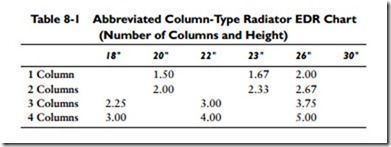Steam Boilers
The boiler is the source of heat for a steam heating system, and it will operate on a number of different fuels; however, regardless of the fuel used, the operating principle will be the same. Water is heated until it boils and changes to steam. The steam is then dis- tributed to the heat-emitting units throughout the structure either by natural or mechanical means.
Low-pressure steam heating boilers are used in residences and small buildings. The design and construction of these boilers are very similar to the boilers used in hot-water heating systems in the same size. Both boilers are described in considerable detail in Chapter 15 (“Boilers and Boiler Fittings”).
To size a steam boiler, first measure the height in inches of one cast-iron radiator in the system. Then, count the number of sections and the number of tubes or columns (Figure 8-59). The sections are the divisions or separations of a cast-iron radiator as seen when standing directly in front of it. When you look at the radiator from its narrow end, you can see that each section consists of one or more vertical pipes.
Note
These vertical pipes are called columns in the traditional cast- iron radiators and are 21⁄2 inches wide. In newer radiators, they are called tubes and are only 11⁄2 inches wide.
Find the square foot Equivalent Direct Radiation (EDR) of one section of the radiator from Table 8-1. Multiply that figure by the number of sections in the radiator to arrive at the square foot EDR rating of that radiator. Multiply the square foot EDR rating by 240 Btu per hour to obtain the heating capacity of that one radiator. Calculate the design heating capacity for each of the remaining radiators in the heating system. The sum of the design heating capacities of all the radiators is the total radiation heating demand on the boiler.

